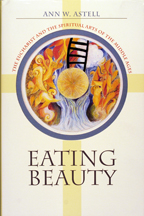
English prof explores Eucharist in art, philosophy, theology
WEST LAFAYETTE, Ind. — A Purdue University medieval scholar is taking a "beautiful" look at how art, history, literature and philosophy relate to the Holy Eucharist, a Catholic sacrament.

|
The eating of beauty phrase is portrayed in art as the mouth of hell or in reference to the Christian story of Adam and Eve eating forbidden fruit in the Garden of Eden and, as a result, dooming humankind, Astell says. Geoffery Chaucer, Virginia Woolf, Simone Weil and G.W.F. Hegel are some of the writers and philosophers who have incorporated themes of eating and beauty in their work.
"And images of food in religion are nothing new," says Astell, who also is a member of the Schoenstatt Sisters of Mary. "But, what I saw missing from many of these discussions is consideration for the Holy Eucharist as a source of beauty."
This Eucharistic rite, also known as Holy Communion, is practiced in honor of Christ's Last Supper before he was crucified. It is believed that Christ has a presence in the bread and wine that is consumed by followers, symbolic of Christ entering the human body and soul. In this way those who receive the Eucharist are drawn into Christ's own risen life and beauty, Astell says.
"Many people think that eating and appreciating beauty are two different actions," Astell says. "Eating, which can lead to gluttony and greed, is seen as destructive of beauty. It is assumed that eating beauty destroys it. But in the Eucharist tradition, the opposite is the case, because consuming the Eucharist shows that a person can eat what is considered the most incredible beauty. Nothing is destroyed; instead, life is flourishing."
She also analyzes the Eucharist as its own form of art with Christ as the artist. Astell explores these topics in her book "Eating Beauty: The Eucharist and the Spiritual Arts of the Middle Ages," which was published by Cornell University Press ($39.95) in August.
Examples, anecdotes and works from history, English, art, theology and philosophy are featured in the book. The book also includes color images of artwork by Michelangelo and other works of art featuring eating beauty images, saints and religious scenes.
Astell, who teaches a course on medieval women mystics, also is author of "Joan of Arc and Sacrificial Authorship," "The Song of Songs in the Middle Ages," "Chaucer and the Universe of Learning" and "Political Allegory in Late Medieval England." Astell is chair of Purdue's Medieval Studies program.
The Department of English is housed in the College of Liberal Arts.
Writer: Amy Patterson Neubert, (765) 494-9723, apatterson@purdue.edu
Source: Ann Astell, (765) 494-3720, astell@purdue.edu
Purdue News Service: (765) 494-2096; purduenews@purdue.edu
To the News Service home page